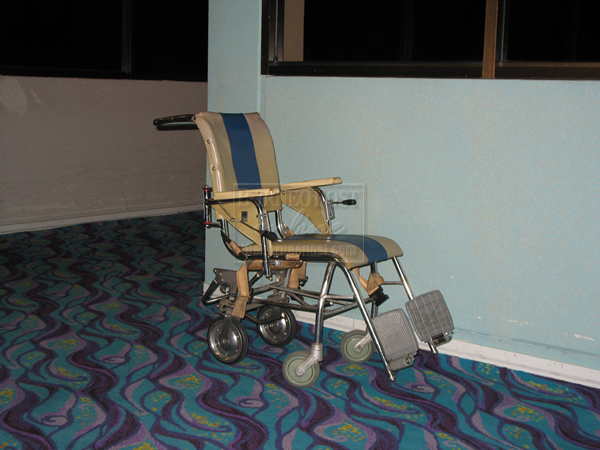Air travel tips for wheelchair users
by Peter Tan. Posted on September 28, 2013, Saturday

SPECIFIC FUNCTION: Aircraft boarding chairs enable persons with mobility impairments to get in and out of an aeroplane.
AIR travel has made the world smaller. Journeys between continents in the present day can be accomplished in a matter of hours instead of days or weeks. Now more than ever, we travel for a variety of purposes, from leisure and business to education and medical treatment. This mode of transport is no longer a luxury but a necessity that is convenient and saves time.
Despite the advances of modern air travel, it can still be a daunting experience for wheelchair users, especially when there are horror stories of passengers with mobility impairments being barred from boarding or wheelchairs coming out from the cargo hold damaged beyond repair. These traumatising incidences can be reduced by observing some simple guidelines.
As a general rule of thumb, full-service airlines are better at supporting passengers requiring assistance. Nonetheless, low cost airlines are bound to provide a basic level of service to accommodate disabled passengers as well.
The airlines must be informed of assistance and equipment required at the time of making reservations and whether one can transfer to the aircraft seat independently or require additional support. Most aisle seats except for the front row have lift-up armrests. These allow for easier transfer to the seat and can be reserved at the time of booking.
Some airlines have strict policies that require disabled passengers to occupy window seats only in single aisle aircraft. This is apparently to ensure that they are not in the way to allow for the quick evacuation of other passengers in the event of an emergency.
For long distance flights of more than four hours, it is advisable to request for an aisle chair to be available in the cabin to get to the toilet. Certain larger aircraft have privacy curtains beside the aft toilet for this purpose if the toilet itself is not accessible. This request should be made known at the time of reservation and noted down in the system so that the service staff are aware of the needs and make the necessary arrangements accordingly.
It is recommended to arrive early at the airport. Passengers must check-in two hours before departure for international flights and one hour for domestic flights. During busy periods, it may take longer to check-in and go through immigration. Time allowance should be made for using the toilet before getting into the aircraft. Wheelchair users are always first to board and this should also be taken into account.
There are counters that passengers can approach for additional support after checking in. The staff at these counters provide wheelchair loans and complimentary ground assistance right up to the aircraft seat. Wheelchair users can request to remain in their own manual wheelchairs up to the aircraft door and then transfer to an aircraft boarding chair to get into the cabin rather than transfer to an airline wheelchair when checking in.
All detachable and removable parts like armrests and the cushion must be fastened or detached and taken into the cabin if possible. The wheelchair should be affixed with a ‘Deliver At Aircraft’ and ‘Fragile – Handle with Care’ tags to caution the baggage handlers to practise utmost care when stowing the equipment and deliver it to the aircraft door upon arrival. Otherwise, the wheelchair can only be collected at the baggage claim area.
All motorised wheelchairs must be checked-in together with the luggage although they are not included as part of the luggage weight allowance. As a matter of safety, airlines may require liquid-filled batteries to be disassembled and stowed separately to prevent leakages. It will be helpful to have the proper tools and disassembly instructions handy for this task.
The aircraft of full service airlines are usually docked to boarding bridges for seamless embarkation and disembarkation. On the other hand, low cost carriers require passengers to go across the tarmac and climb up boarding stairs to get into the aircraft.
Passengers who are unable to climb up the stairs may request for a boarding lift (also known as an ambulift) if the facility is available. Where it is not, passengers have to be carried up to the aircraft by the ground crew. In such cases, passengers must be aware of the risks of accidents no matter how well-trained the crew members are.
After settling down in the seat and before other passengers begin to board, a cabin crew member will usually inform disabled passengers that they will be the last to disembark upon arrival of the destination. At the same time, the cabin crew can be gently reminded of the possible need for assistance to get to the toilet at specific times during the flight. It must be noted that the cabin crew will not assist disabled passengers with personal tasks other than the passage to the toilet and back.
At the destination, the ground crew will bring an aircraft boarding chair and assist disabled passengers after the other passengers have disembarked. The wheelchair should be waiting right outside the aircraft door or on the tarmac by the boarding stairs.
That is a good time to check for damage. Ensure that the wheelchair tracks straight when being pushed. Any damage should be reported immediately to the ground crew and the airline. If there is any major damage resulting in the wheelchair being unusable, insist that the airline provide a loan wheelchair for temporary use pending repair or replacement.
A broken wheelchair will definitely be a bad start to a journey in a foreign land but this is something wheelchair users must anticipate and be prepared to face when travelling. A little bit of planning beforehand and awareness of the procedures practised by the various airlines can reduce anxiety and make a difference in making the journey more pleasant.
Comments can reach the writer via columnists@theborneopost.com.
Read more: http://www.theborneopost.com/2013/09/28/air-travel-tips-for-wheelchair-users/#ixzz2gSAcPmch
